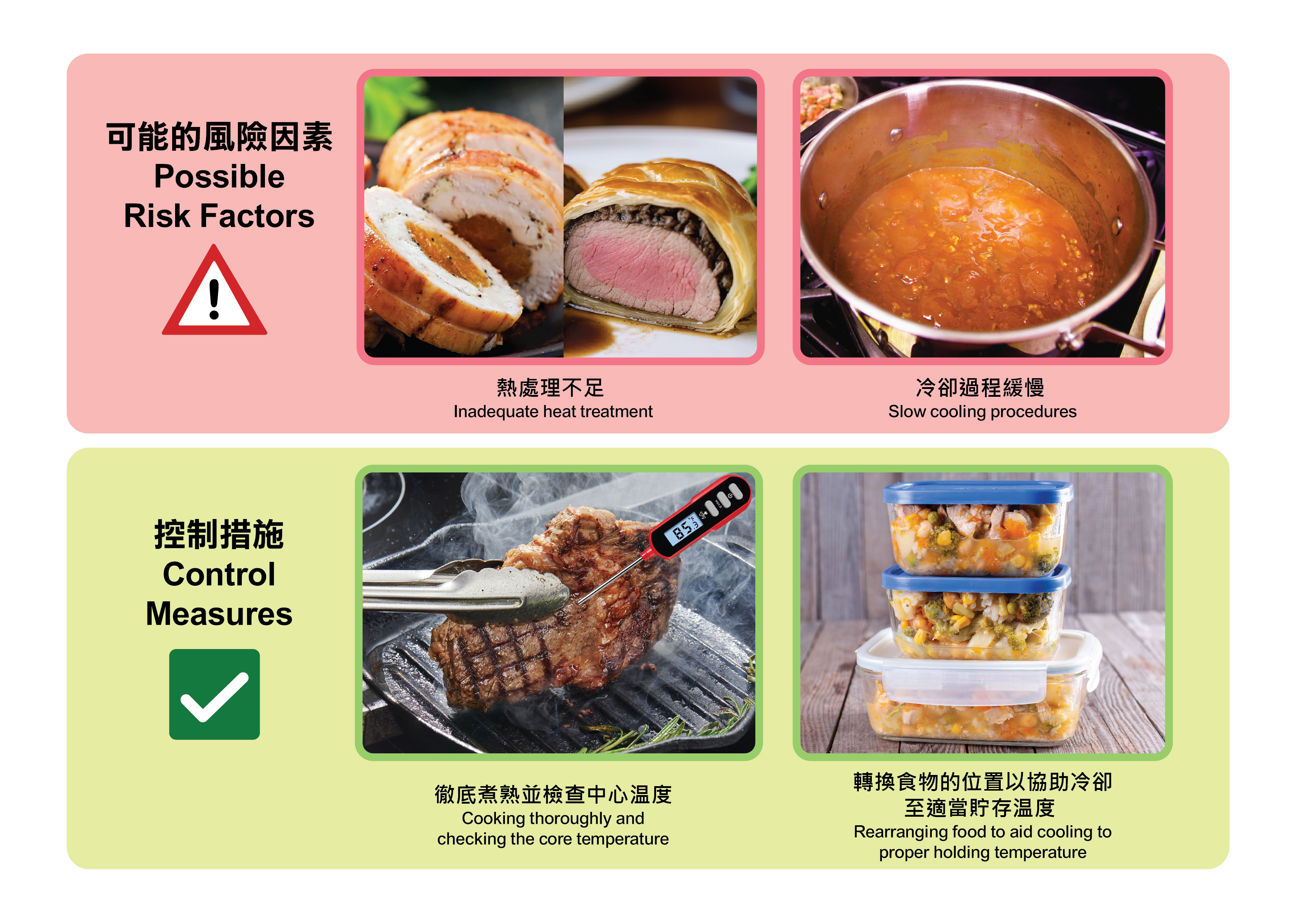
Food Safety Focus (212nd Issue, March 2024) – Article 2
Clostridium perfringens – A Threat to Food Safety
Reported by Mr. Kenneth YIP, Scientific Officer,
Risk Communication Section, Centre for Food Safety
Recently, there was a suspected food poisoning outbreak in sheltered workshops associated with meals from a food factory. The incriminated food item was suspected to be pork with gravy and the probable causative agent was Clostridium perfringens. Clostridium perfringens is reported to be a common cause of foodborne illness. The risk factors for food poisoning caused by Clostridium perfringens will be covered in this article along with control measures to reduce food safety risks.
How does Clostridium perfringens cause food poisoning?
Clostridium perfringens is a spore-forming bacterium widely found in the environment including soil and water. Incriminated food items linked to Clostridium perfringens are high-starch and high-protein items such as gravies, thick soups, cooked beans and rolled meat. Unhygienic and improper food handling practices could introduce the bacteria to kitchens, resulting in the contamination of cooked food by raw ingredients.
While vegetative cells of Clostridium perfringens can survive within the temperature danger zone of 4-60oC and grow best at its optimal temperature of 43oC, spores can survive at extreme temperatures. Ingesting a large number of vegetative cells or their spores (>106 spores or cells per gram of food) is required to cause food poisoning. Enterotoxin is produced during sporulation and remains enclosed within the cells until cell lysis occurs to release the mature spores. When contaminated food is consumed, the vegetative cells can form spores and release enterotoxins in the gut, which could lead to gastroenteritis with symptoms like watery diarrhoea and abdominal pain. The onset time is usually about 10-12 hours and the recovery time is around 24-48 hours.
Inadequate Heat Treatment and Slow Cooling Procedures – Common Risk Factors
Consuming undercooked food and long cooling time are major contributing factor of Clostridium perfringens food poisoning, especially in settings where food is prepared in large volume. Undercooking may not eliminate the vegetative cells of Clostridium perfringens in contaminated food and bacterial growth could still take place. In some cases, food is subject to adequate cooking temperature during preparation, but uneven heat distribution from the heat source could also lead to food not being thoroughly cooked. Food items such as rolled meats could be risky due to slow heat penetration to the core, so they may be still undercooked after heat treatment. In the said suspected food poisoning case, the marinated pork chop was checked by cutting and checking the colour change of the meat after deep frying. Such observation findings may not be reliable in judging whether the pork is thoroughly cooked.
Some may claim that thoroughly cooked food is always safe, yet extra precautions should be taken for food commonly linked to Clostridium perfringens food poisoning. Thorough cooking can kill vegetative cells, but spores formed by Clostridium perfringens are not destroyed by normal cooking temperature and may survive in food. While heating activates spore germination, slow cooling of cooked food allows time for the growing of bacteria to a large number. Overseas reports indicated that allowing foods for slow cooling or leaving foods unrefrigerated for hours are known contributing factors. Clostridium perfringens food poisoning is more likely to happen in settings involving large groups of people to be served, like nursing homes and schools, since it may take a longer duration to serve cooked food after preparation while maintaining the food at a safe temperature may also be difficult. In addition, if large amounts of food have to be refrigerated, heat energy may still be trapped in the food. Exposing food within the temperature danger zone for a prolonged period during cooling could provide favourable conditions for bacterial proliferation.

Figure: Risk factors of Clostridium perfringens food poisoning and control measures
Cooking Thoroughly, Proper Cooling and Proper Holding Temperatures - Key Control Measures
To reduce the risk of Clostridium perfringens food poisoning, it is essential to ensure that food is thoroughly cooked with the core temperature of the food reaching at least 75oC. Proper cooking temperature kills vegetative cells. Ideally, a food thermometer is used to check the core food temperature. It should be inserted into the centre of the thickest part of the food and it should not touch a bone or the side of the container. Leftovers should be reheated thoroughly before consumption and should not be reheated more than once.
When storing cooked foods, they should be kept at proper hot (above 60oC) or cold (at or below 4oC) holding temperatures as soon as possible to minimise the time exposed within the temperature danger zone. Ingredients and cooked food should be kept properly to avoid contamination. Dividing food into smaller portions and placing food in shallow containers can facilitate the cooling process. Whenever food has to be kept at room temperature, it is best to follow the “2-hour/4-hour rule”.

